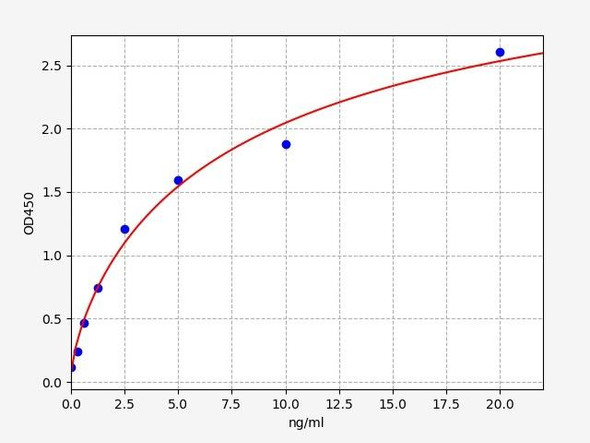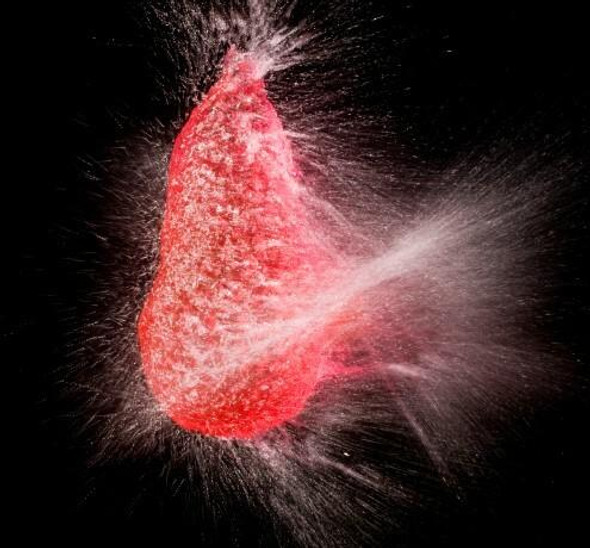Rat Immunology ELISA Kits 2
Rat pAMPK / Phosphorylated Adenosine Monophosphate ActivatedKinase ELISA Kit
- SKU:
- RTFI00566
- Product Type:
- ELISA Kit
- Size:
- 96 Assays
- Uniprot:
- Q09137
- Sensitivity:
- 1.875ng/ml
- Range:
- 3.125-200ng/ml
- ELISA Type:
- Sandwich
- Synonyms:
- AMPK
- Reactivity:
- Rat
- Research Area:
- Autophagy
Description
| Product Name: | Rat AMPK (Phosphorylated Adenosine Monophosphate Activated Protein Kinase) ELISA Kit |
| Product Code: | RTFI00566 |
| Size: | 96 Assays |
| Target: | Rat AMPK |
| Alias: | AMPK |
| Reactivity: | Rat |
| Detection Method: | Sandwich ELISA, Double Antibody |
| Sensitivity: | 1.875ng/ml |
| Range: | 3.125-200ng/ml |
| Storage: | 4°C for 6 months |
| Note: | For Research Use Only |
| Recovery: | Matrices listed below were spiked with certain level of Rat AMPK and the recovery rates were calculated by comparing the measured value to the expected amount of Rat AMPK in samples. | ||||||||||||||||
| |||||||||||||||||
| Linearity: | The linearity of the kit was assayed by testing samples spiked with appropriate concentration of Rat AMPK and their serial dilutions. The results were demonstrated by the percentage of calculated concentration to the expected. | ||||||||||||||||
| |||||||||||||||||
| Intra-Assay: | CV <8% | ||||||||||||||||
| Inter-Assay: | CV <10% |
| Uniprot: | Q09137 |
| UniProt Protein Function: | AMPKA2: a catalytic subunit of AMP-activated protein kinase (AMPK). Acts as an energy sensor, playing a key role in regulating cellular energy metabolism. A protein kinase of the CAMKL family whose activation is regulated by the balance between ADP/AMP/ATP, and intracellular Ca(2+) levels. Acts as a metabolic stress-sensing protein kinase switching off biosynthetic pathways when cellular ATP levels are depleted and when 5'-ADP and -AMP rise in response to fuel limitation and/or hypoxia. Activates energy-producing pathways and inhibits energy-consuming processes. Restores ATP levels in cells by switching off anabolic and switching on catabolic pathways. Activated primarily by rising ADP levels and not, as previously thought, solely by AMP. AMPK resembles an adenylate charge regulatory system in which anabolic and catabolic pathways are regulated by adenine nucleotide ratios. Acts via direct phosphorylation of metabolic enzymes and transcription regulators. Regulates fatty acid synthesis by phosphorylating acetyl-CoA carboxylase. Regulates cholesterol synthesis by phosphorylating and inactivating hormone-sensitive lipase and hydroxymethylglutaryl-CoA reductase. Activated by at least two distinct upstream kinases: the tumor suppressor LKB1 and CaMKK2. Also acts as a regulator of cellular polarity by remodeling the actin cytoskeleton, probably by indirectly activating myosin. AMPK is a heterotrimer of an alpha catalytic subunit (AMPKA1 or -2), a beta (AMPKB1 or -2) and a gamma non-catalytic subunit (AMPKG1, -2 or -3). Different possible combinations of subunits give rise to 12 different holoenzymes. Binding of ADP or AMP to non-catalytic gamma subunit (PRKAG1, -2 or -3) results in allosteric activation. AMPK is activated by antihyperglycemic drug metformin, a drug prescribed to patients with type 2 diabetes: in vivo, metformin seems to mainly inhibit liver gluconeogenesis. However, metformin can be used to activate AMPK in muscle and other cells in culture or ex vivo. Selectively inhibited by compound C (6-[4-(2-Piperidin-1-yl-ethoxy)-phenyl)]-3-pyridin-4-yl-pyyrazolo[1,5-a] pyrimidine. Activated by resveratrol, a natural polyphenol present in red wine, and S17834, a synthetic polyphenol. Salicylate/aspirin directly activates kinase activity. Studies in the mouse suggest that AMPK2 may control whole-body insulin sensitivity and is necessary for maintaining myocardial energy homeostasis during ischemia. |
| UniProt Protein Details: | Protein type:Protein kinase, Ser/Thr (non-receptor); EC 2.7.11.27; EC 2.7.11.1; Kinase, protein; Autophagy; Protein kinase, CAMK; EC 2.7.11.31; CAMK group; CAMKL family; AMPK subfamily Chromosomal Location of Human Ortholog: 1p31 Cellular Component: nucleoplasm; cytosol Molecular Function:AMP-activated protein kinase activity; protein serine/threonine kinase activity; protein binding; metal ion binding; [acetyl-CoA carboxylase] kinase activity; protein serine/threonine/tyrosine kinase activity; chromatin binding; histone serine kinase activity; ATP binding; protein kinase activity; [hydroxymethylglutaryl-CoA reductase (NADPH)] kinase activity Biological Process: lipid biosynthetic process; rhythmic process; cellular lipid metabolic process; carnitine shuttle; glucose homeostasis; signal transduction; protein amino acid phosphorylation; cellular response to glucose starvation; cellular response to nutrient levels; regulation of fatty acid biosynthetic process; regulation of transcription, DNA-dependent; response to stress; cell cycle arrest; positive regulation of autophagy; fatty acid biosynthetic process; mitochondrion organization and biogenesis; negative regulation of TOR signaling pathway; Wnt receptor signaling pathway; transcription, DNA-dependent; organelle organization and biogenesis; regulation of circadian rhythm; cholesterol biosynthetic process; fatty acid homeostasis; positive regulation of glycolysis; insulin receptor signaling pathway; energy reserve metabolic process; autophagy; negative regulation of apoptosis |
| UniProt Code: | Q09137 |
| NCBI GenInfo Identifier: | 46877068 |
| NCBI Gene ID: | 5563 |
| NCBI Accession: | NP_006243 |
| UniProt Secondary Accession: | Q09137,Q9H1E8, Q9UD43, |
| UniProt Related Accession: | P54646,AAB32732 |
| Molecular Weight: | 62,320 Da |
| NCBI Full Name: | 5'-AMP-activated protein kinase catalytic subunit alpha-2 |
| NCBI Synonym Full Names: | protein kinase, AMP-activated, alpha 2 catalytic subunit |
| NCBI Official Symbol: | PRKAA2 |
| NCBI Official Synonym Symbols: | AMPK; AMPK2; PRKAA; AMPKa2 |
| NCBI Protein Information: | 5'-AMP-activated protein kinase catalytic subunit alpha-2; 5'-AMP-activated protein kinase, catalytic alpha-2 chain; ACACA kinase; AMP-activated protein kinase alpha-2 subunit variant 2; AMP-activated protein kinase alpha-2 subunit variant 3; AMPK alpha 2 |
| UniProt Protein Name: | 5'-AMP-activated protein kinase catalytic subunit alpha-2 |
| UniProt Synonym Protein Names: | Acetyl-CoA carboxylase kinase (EC:2.7.11.27); ACACA kinase; Hydroxymethylglutaryl-CoA reductase kinase (EC:2.7.11.31); HMGCR kinase |
| UniProt Gene Name: | PRKAA2 |
| UniProt Entry Name: | AAPK2_HUMAN |
| Step | Procedure |
| 1. | Set standard, test sample and control (zero) wells on the pre-coated plate respectively, and then, record their positions. It is recommended to measure each standard and sample in duplicate. Wash plate 2 times before adding standard, sample and control (zero) wells! |
| 2. | Aliquot 0.1ml standard solutions into the standard wells. |
| 3. | Add 0.1 ml of Sample / Standard dilution buffer into the control (zero) well. |
| 4. | Add 0.1 ml of properly diluted sample ( Human serum, plasma, tissue homogenates and other biological fluids.) into test sample wells. |
| 5. | Seal the plate with a cover and incubate at 37°C for 90 min. |
| 6. | Remove the cover and discard the plate content, clap the plate on the absorbent filter papers or other absorbent material. Do NOT let the wells completely dry at any time. Wash plate X2. |
| 7. | Add 0.1 ml of Biotin- detection antibody working solution into the above wells (standard, test sample & zero wells). Add the solution at the bottom of each well without touching the side wall. |
| 8. | Seal the plate with a cover and incubate at 37°C for 60 min. |
| 9. | Remove the cover, and wash plate 3 times with Wash buffer. Let wash buffer rest in wells for 1 min between each wash. |
| 10. | Add 0.1 ml of SABC working solution into each well, cover the plate and incubate at 37°C for 30 min. |
| 11. | Remove the cover and wash plate 5 times with Wash buffer, and each time let the wash buffer stay in the wells for 1-2 min. |
| 12. | Add 90 µL of TMB substrate into each well, cover the plate and incubate at 37°C in dark within 10-20 min. (Note: This incubation time is for reference use only, the optimal time should be determined by end user.) And the shades of blue can be seen in the first 3-4 wells (with most concentrated standard solutions), the other wells show no obvious color. |
| 13. | Add 50 µL of Stop solution into each well and mix thoroughly. The color changes into yellow immediately. |
| 14. | Read the O.D. absorbance at 450 nm in a microplate reader immediately after adding the stop solution. |
When carrying out an ELISA assay it is important to prepare your samples in order to achieve the best possible results. Below we have a list of procedures for the preparation of samples for different sample types.
| Sample Type | Protocol |
| Serum: | If using serum separator tubes, allow samples to clot for 30 minutes at room temperature. Centrifuge for 10 minutes at 1,000x g. Collect the serum fraction and assay promptly or aliquot and store the samples at -80°C. Avoid multiple freeze-thaw cycles. If serum separator tubes are not being used, allow samples to clotovernight at 2-8°C. Centrifuge for 10 minutes at 1,000x g. Removeserum and assay promptly or aliquot and store the samples at-80°C. Avoid multiple freeze-thaw cycles. |
| Plasma: | Collect plasma using EDTA or heparin as an anti-coagulant. Centrifuge samples at 4°C for 15 mins at 1000 × g within 30 mins of collection. Collect the plasma fraction and assay promptly or aliquot and store the samples at -80°C. Avoid multiple freeze-thaw cycles.Note: Over haemolysed samples are not suitable for use with this kit. |
| Urine & Cerebrospinal Fluid: | Collect the urine (mid-stream) in a sterile container, centrifuge for 20 mins at 2000-3000 rpm. Remove supernatant and assay immediately. If any precipitation is detected, repeat the centrifugation step. A similar protocol can be used for cerebrospinal fluid. |
| Cell Culture Supernatant: | Collect the cell culture media by pipette, followed by centrifugation at 4°C for 20 mins at 1500 rpm. Collect the clear supernatant and assay immediately. |
| Cell Lysates: | Solubilize cells in lysis buffer and allow to sit on ice for 30 minutes. Centrifuge tubes at 14,000 x g for 5 minutes to remove insoluble material. Aliquot the supernatant into a new tube and discard the remaining whole cell extract. Quantify total protein concentration using a total protein assay. Assay immediately or aliquot and store at ≤ -20°C. |
| Tissue Homogenates: | The preparation of tissue homogenates will vary depending upon tissue type. Rinse tissue with 1X PBS to remove excess blood & homogenizein 20ml of 1X PBS (including protease inhibitors) and store overnight at ≤ -20°C. Two freeze-thaw cycles are required to break the cell membranes. To further disrupt the cell membranes you can sonicate the samples. Centrifuge homogenates for 5 mins at 5000xg. Remove the supernatant and assay immediately or aliquot and store at -20°C or-80°C. |
| Tissue Lysates: | Rinse tissue with PBS, cut into 1-2 mm pieces, and homogenize with a tissue homogenizer in PBS. Add an equal volume of RIPA buffer containing protease inhibitors and lyse tissues at room temperature for 30 minutes with gentle agitation. Centrifuge to remove debris. Quantify total protein concentration using a total protein assay. Assay immediately or aliquot and store at ≤ -20 °C. |
| Breast Milk: | Collect milk samples and centrifuge at 10,000 x g for 60 min at 4°C. Aliquot the supernatant and assay. For long term use, store samples at -80°C. Minimize freeze/thaw cycles. |






